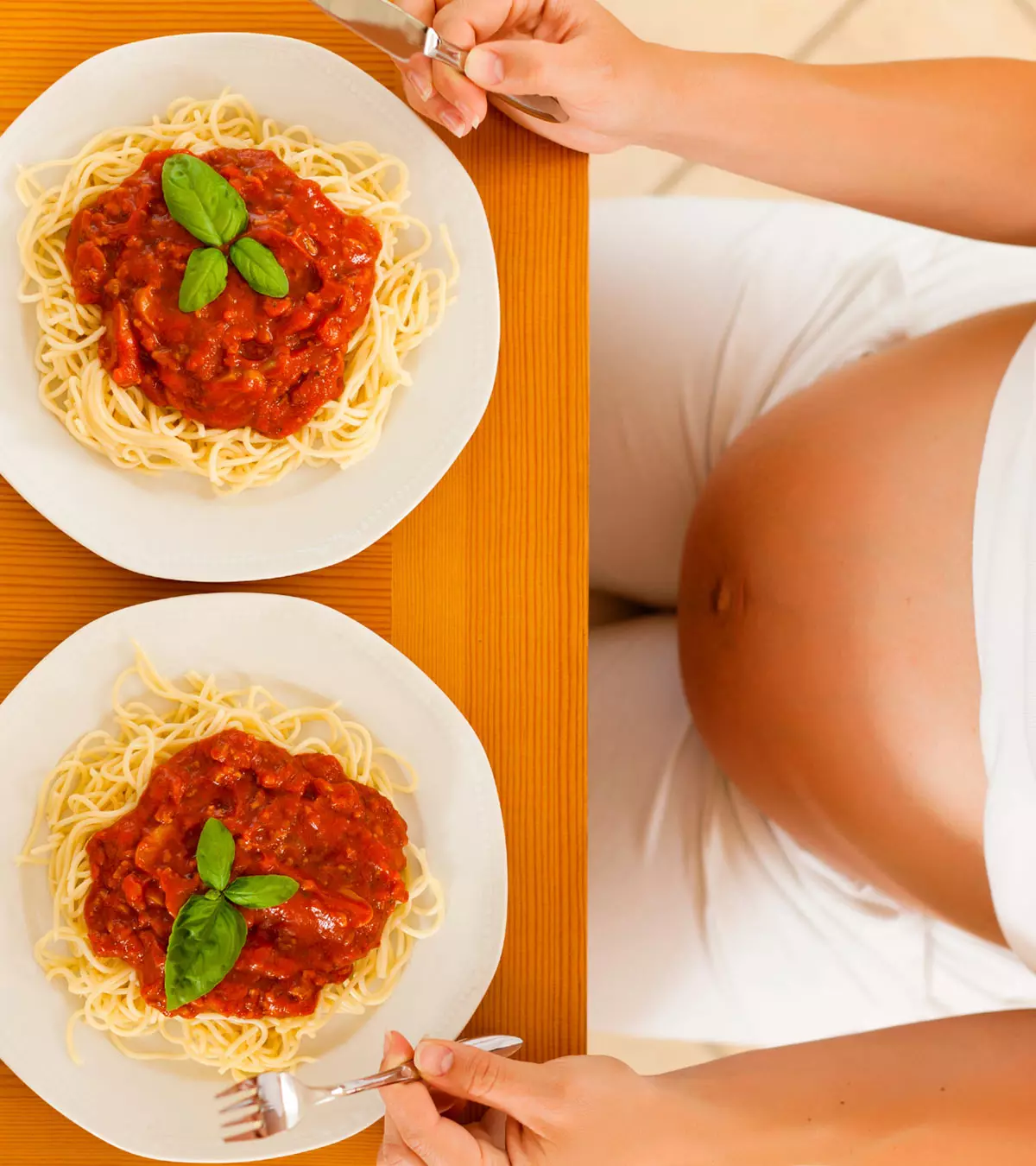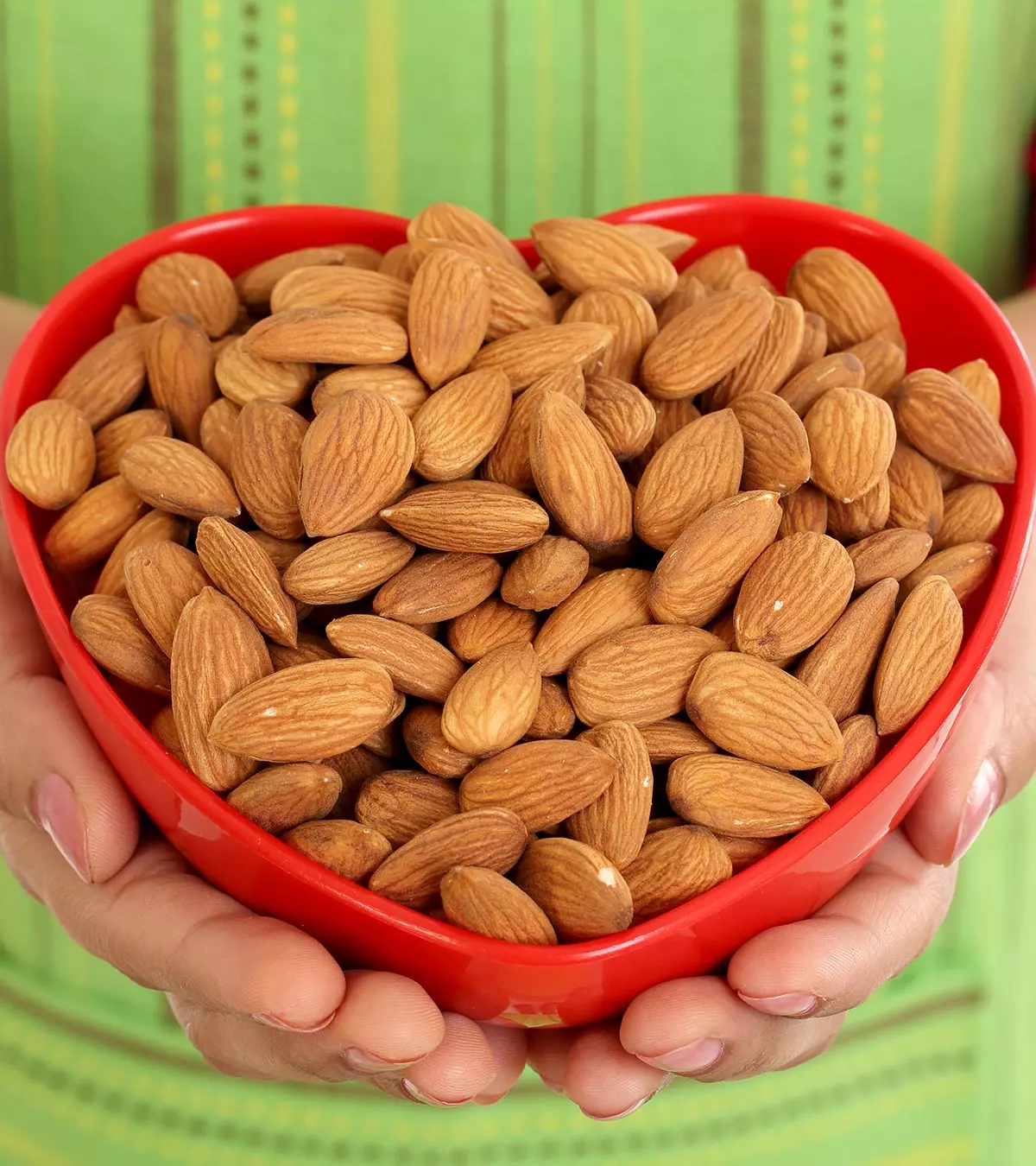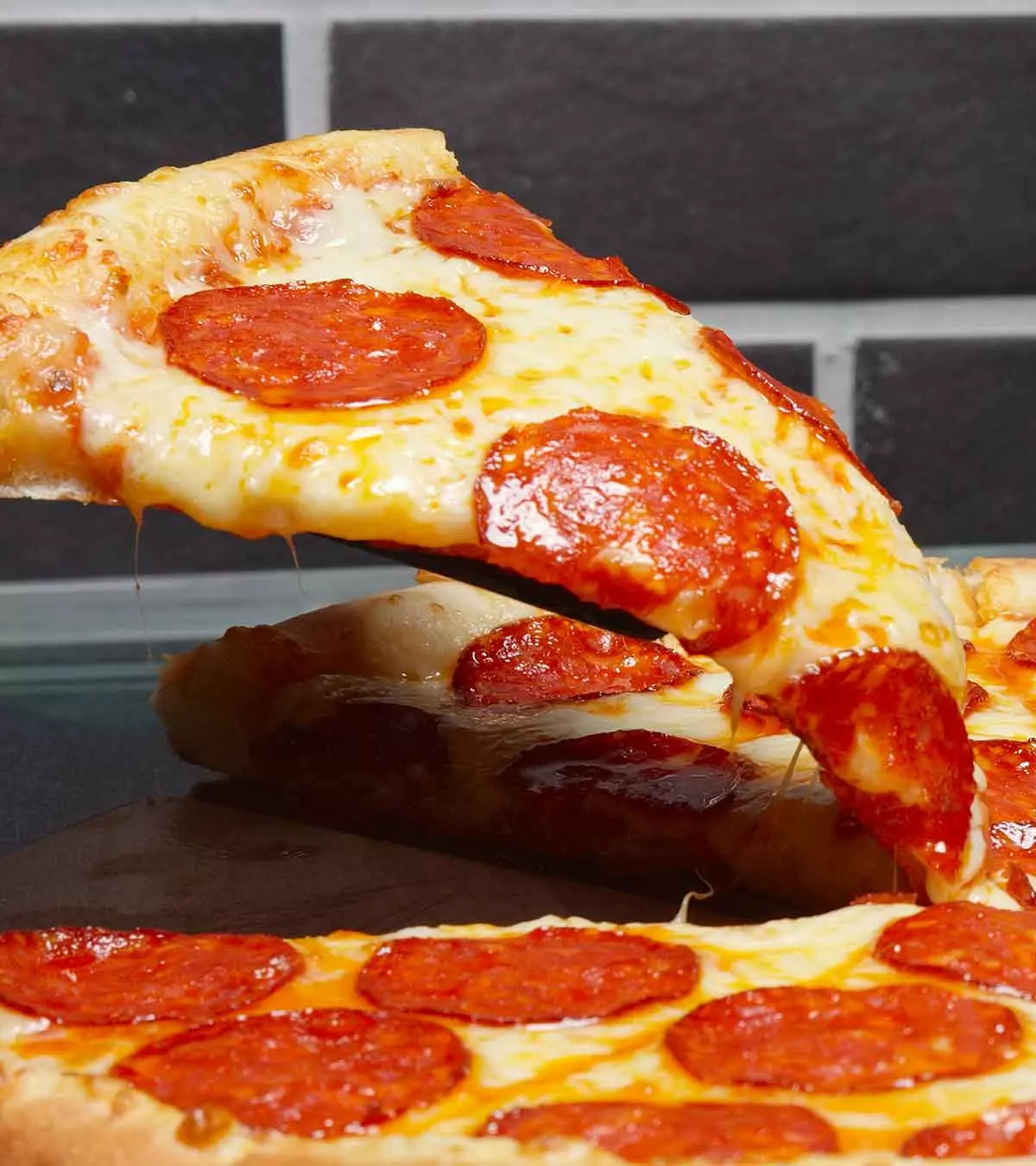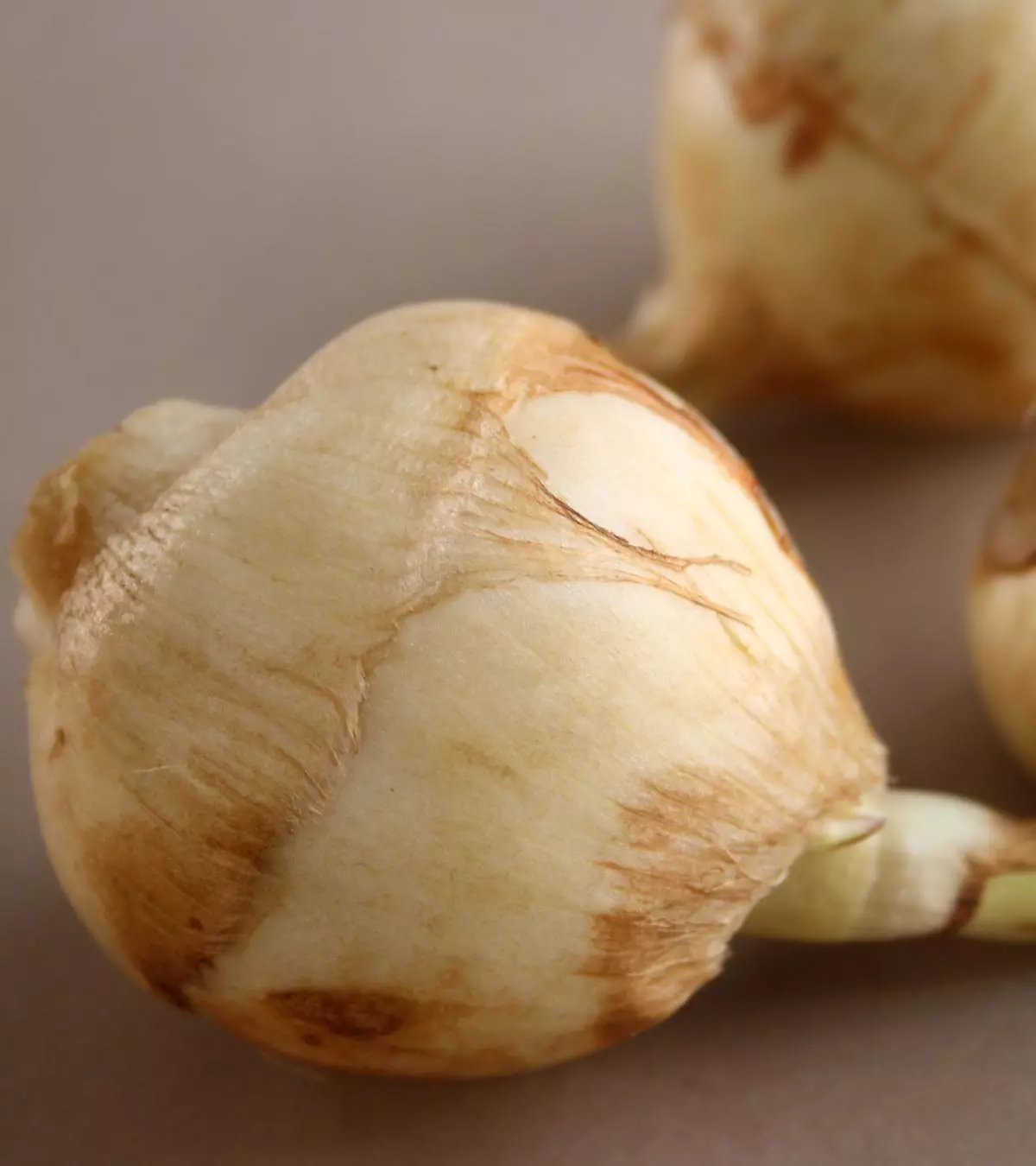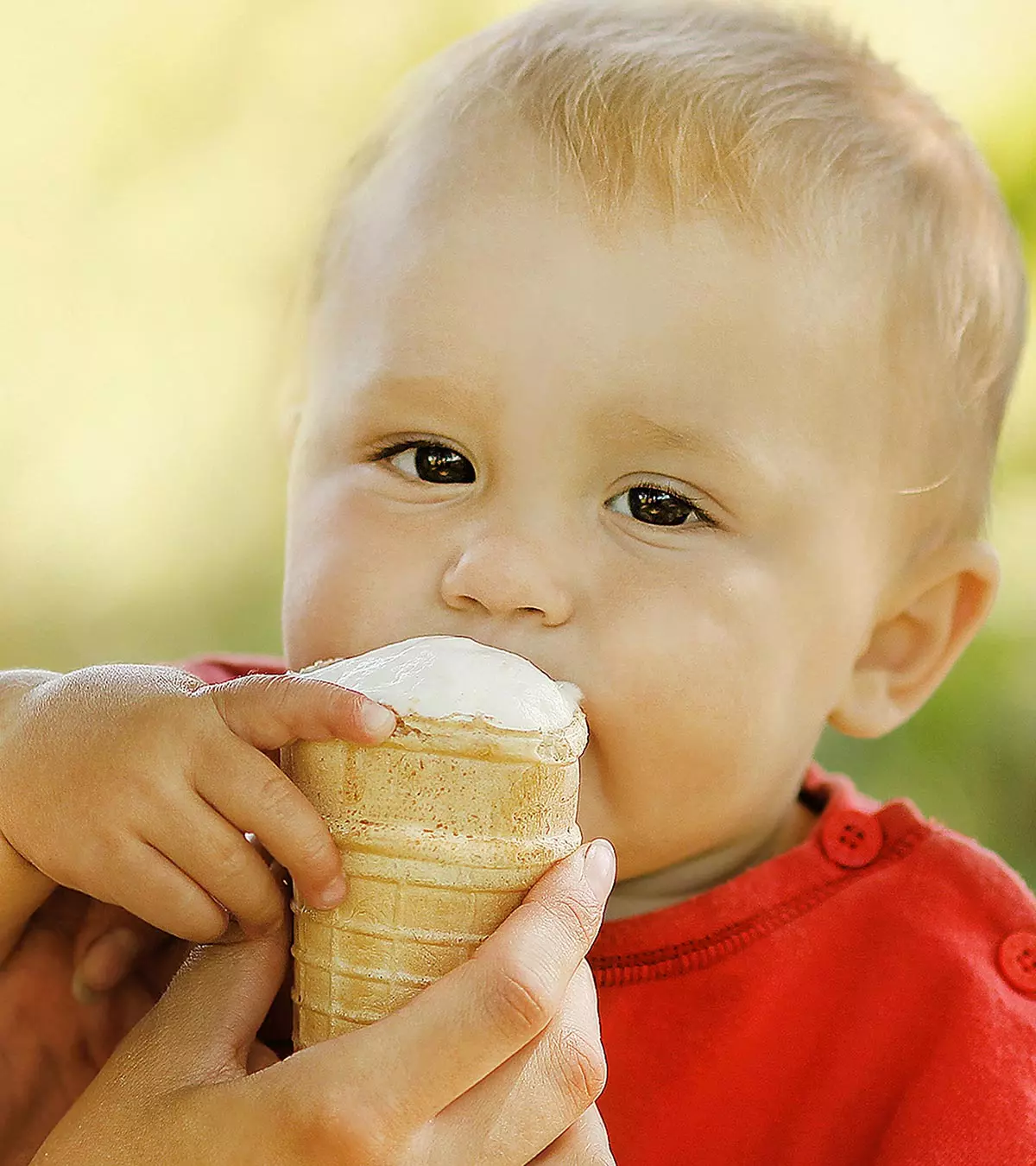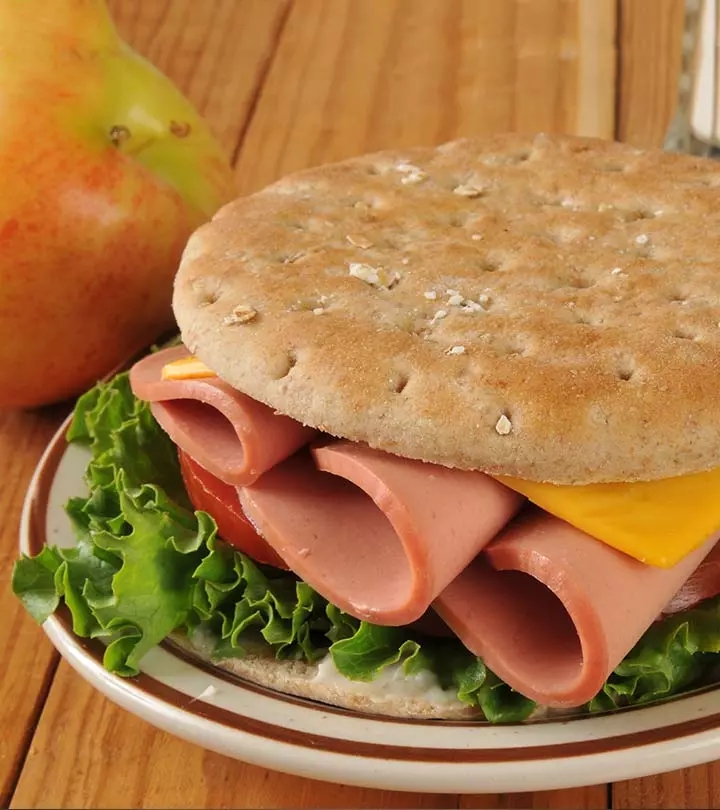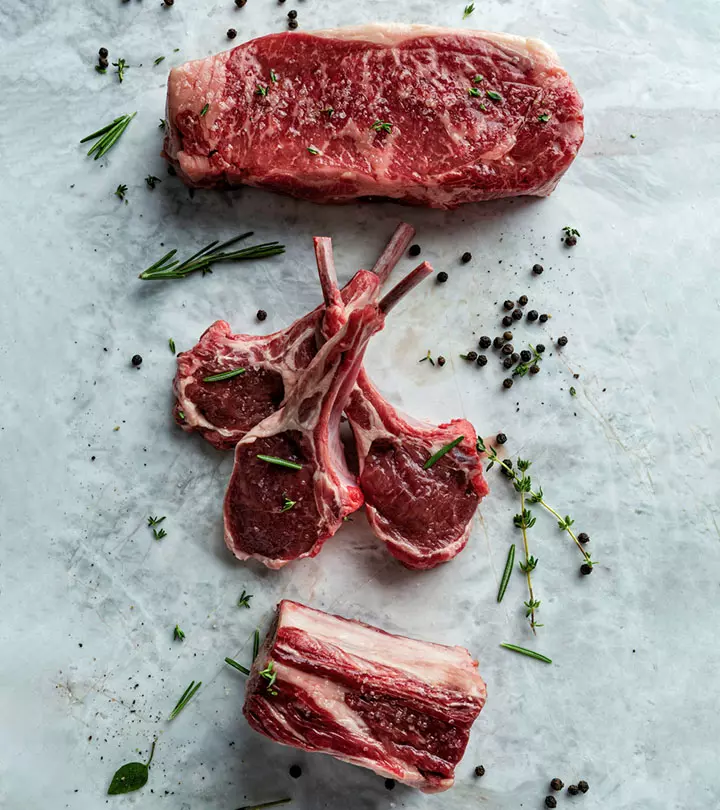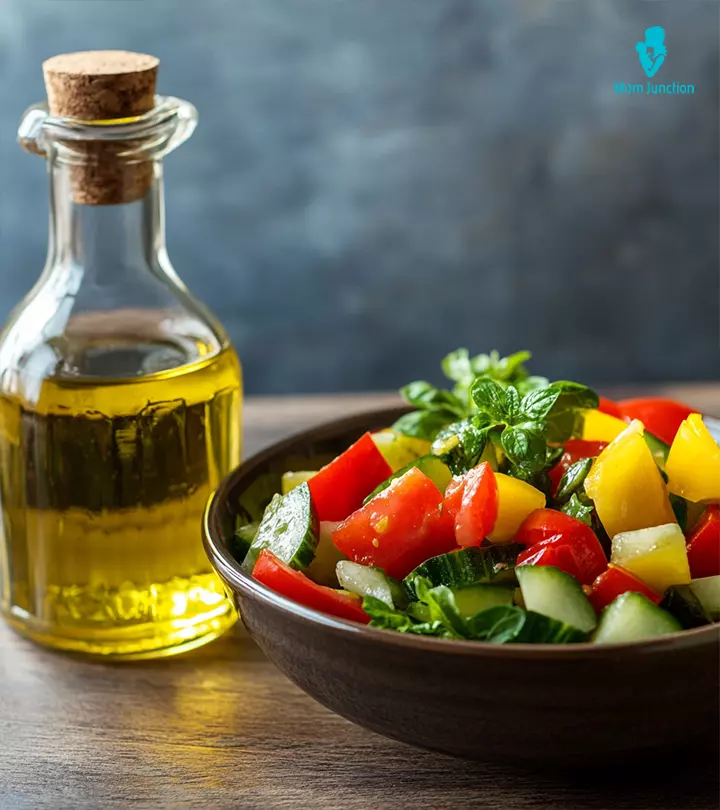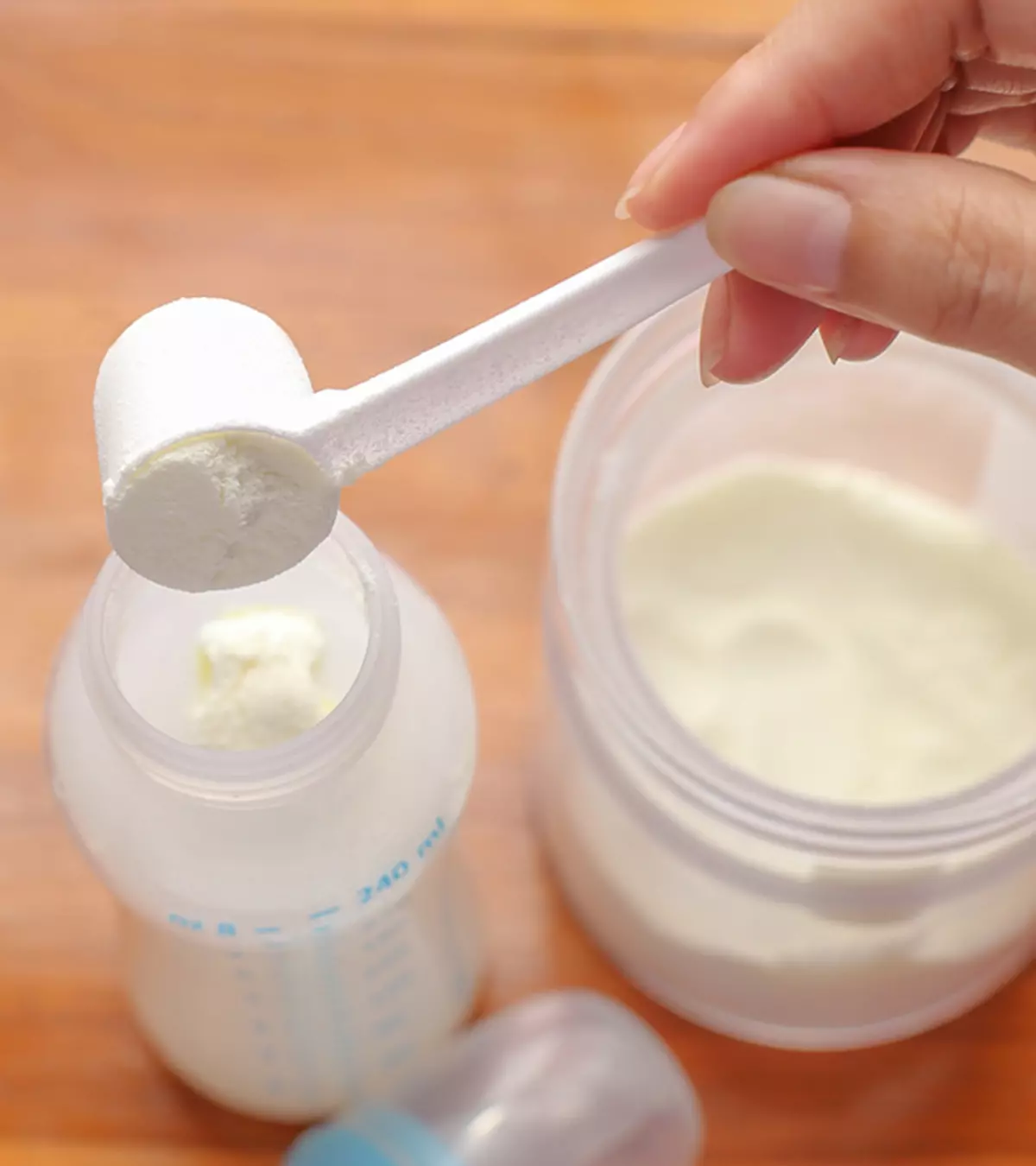
Image: Shutterstock
Cranberries for babies are a healthy snack option or not, which requires quite some discussion. Cranberries are acidic fruits that come in various forms, including fresh, dried, and processed forms like juice. The fruit’s unique nutritional and therapeutic features inspire parents to include it in their child’s diet. The benefits of cranberry for newborns, on the other hand, are still being studied.

This post covers all you need to know about cranberries, including their advantages, potential side effects, and how to feed them to your baby.
Key Pointers
- Cranberry can be safely given to babies in cooked or baked form.
- Cranberries provide several benefits to babies such as boosting immunity, preventing urinary tract infections, and helping maintain gut health.
- Cranberries may have undesirable side effects in babies such as bloating, loose stools, and allergic reactions.
- Choose smooth, red cranberries for babies. Wash and dry them before storing in the fridge to make them last longer.
Can You Give Cranberries To Babies?
According to the U.S. Food and Drug Administration (USFDA), cranberries are “generally recognized as safe” (GRAS) to consume as food (1). Besides, the fruit has a remarkable phytochemicaliBioactive compounds found in plant-based foods that act as antioxidants and have antimicrobial effects. profile that holds considerable health benefits. Thus, cranberries can be considered a good food choice for babies and toddlers.
At What Age Can Babies Have Cranberries?

Fresh cranberries have a sharp sour to tangy taste and are acidic in nature. Therefore, the fruit should only be fed in a cooked or baked form to infants after the age of eight months. There is also a general belief that babies should not be fed berries before the age of 12 months.
Thus, it is best to consult a nutritionist or a pediatrician before adding cranberry to your baby’s diet. It is especially crucial when the infant has gastrointestinal issues, such as gastric reflux, where concentrated cranberry products may cause problems.
Besides gastric reflux, other gastrointestinal problems can pose challenges when introducing cranberries to babies.
How Much Cranberry Juice Can Babies Drink?
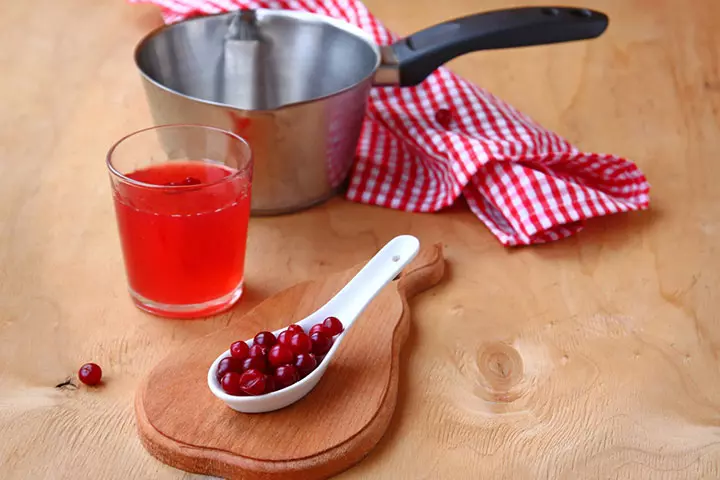
The American Academy of Pediatrics (AAP) advises against the use of juices for babies under the age of 12 months (2). Toddlers between the ages of one to three years can have four ounces (half a cup) of juice in a day (3). If you intend to give cranberry juice to your toddler, then choose 100% natural or homemade cranberry juice without any added sugars. It is best to consult a pediatrician to determine the amount of juice that would be safe for your toddler.
Nutritional Value Of Cranberry Fruit
One cup (110g) of chopped Cranberry provides the following nutrients in comparison to the recommended intake value for each nutrient (4) (5).
| Name | Amount | RDA |
|---|---|---|
| Water | 96.1g | – |
| Energy | 50.6Kcal | – |
| Carbohydrate, by difference | 13.2g | – |
| Dietary fiber (total) | 3.96g | – |
| Calcium, Ca | 8.8mg | 270mg (7-12 months) |
| Magnesium, Mg | 6.6mg | 75mg (7-12 months) |
| Phosphorus, P | 12.1mg | 275mg (7-12 months) |
| Potassium, K | 88mg | 700mg (7-12 months) |
| Sodium, Na | 2.2mg | 200mg (7-12 months) |
| Vitamin C | 15.4mg | 35mg (7-12 months) |
Sources: U.S. Department of Agriculture and World Health Organization
Possible Health Benefits of Cranberries For Infants
Cranberries are likely to provide some vital health benefits to your baby. Some of them are discussed in brief below.
- Aids in digestion and gut health: A cup of cranberry provides sufficient water and dietary fiber to help regulate the bowel movement. Besides, cranberries provide a wide array of phytochemicals such as polyphenolsiNaturally occurring antioxidant compounds found in food items such as fruits, vegetables, coffee, tea, and wine. that could enhance the gut microbiomeiAll bacteria, viruses, fungi, and their genes that live on our bodies and inside us. , and thus have a positive influence on overall health (6). You can serve cranberry sauce or puree, cranberry smoothies, and cranberry applesauce to your baby for aiding healthy digestion.
- Could support immunity: Consumption of cranberry fruit is associated with enhanced systemic immunity. The bioactive compounds present in cranberry may help reduce the symptoms of cold and flu (7).
- Could help reduce oxidative damageiA harm caused to the cells and tissues by highly reactive oxygen containing molecules. : Cranberry extract contains several bioactive compounds such as proanthocyanidinsiChemicals that give red, purple, or blue color to fruits and flowers and might help prevent cancer and some age-related issues. , quercetiniFlavonoids that grants color to many fruits and vegetables and have antioxidant, anti-inflammatory, and antihistamine properties. , and anthocyaninsiDeep red, blue, and purple pigments found in plants. that exhibit strong antioxidant properties (8). They are vital to reduce oxidative stress and enhance cellular integrity – an important physiological mechanism needed to keep chronic health conditions in check.
- May reduce the risk of urinary tract infections (UTI): Although studies on infants are limited, a Centers for Disease Control and Prevention report demonstrates that urinary tract infections are common in children, affecting about 8% of girls and 2% of boys by seven years. E. coli bacterium is the primary causative agent, responsible for around 85% of UTIs. The purported use of cranberry juice to “treat UTI” caused by intestinal bacterium E.coli in children and women is common. However, research shows that A-type proanthocyanidins (class of phytochemicals) can reduce the risk of UTI but not treat it (9).
- May support oral health: Research shows that cranberry juice has the potential to inhibit acid production and host inflammatory response on tooth surfaces (10). It may make it an effective anti-caries agentiSubstances that aid in the prevention of dental cavities. . However, more intensive research is needed to substantiate the finding.

Although research is limited, the nutritional profile of cranberry may also provide possible benefits to gastrointestinal and cardiovascular health (11).
It is pertaining to these and several other desirable health-benefiting properties of cranberry that the health industry has marked it as potential “functional food.” However, there are some side effects of cranberries that should be checked while you plan to introduce the fruit to your baby.
 Quick fact
Quick factPossible Side Effects Of Cranberry For Babies
Cranberry and several of its products, such as cranberry juice, could have some of the following side effects.
- Gastrointestinal disturbance: When consumed in moderation, cranberries and cranberry products seldom cause any issue. However, when consumed in excess, they could lead to digestive issues such as bloating and diarrhea.
- Kidney stones: Kidney stones in infants and toddlers are not common, yet their possibility cannot be entirely ruled out. Pediatric kidney stones could cause recurrent UTIs and colicky pain (12). High consumption of cranberries is associated with kidney stones in predisposed individuals.
- Cross-reactivity: You should also avoid giving cranberry and its products in case your baby is allergic to other berry plants in the Vaccinium genus. A few examples of such berries are blueberry, huckleberry, bilberry, and cowberry.

Proper selection and storage of cranberries is also important to ensure your baby’s safety.
How To Select And Store Cranberries?
You could follow some simple steps to select and store cranberries in the best way possible.
How to select cranberries
According to EWG, cranberry is not a “dirty dozen” food and hence is less likely to be contaminated with pesticides. Nevertheless, it is best to purchase organic cranberries. You can also consider the following steps for the right selection of cranberries.
- Choose fresh cranberries that have a bright red color. The fruit should feel smooth and firm to touch.
- Avoid buying cranberries that feel too soft. Also, do not buy cranberries with dull skin with wrinkles and blemishes on its surface.
- In case you have any doubt, you could do a basic test. Drop a berry on the floor and see if it “bounces.” A fresh berry, when dropped, will bounce due to the small air-filled chambers inside it.
How to store cranberries
- Clean the berries under cold running water, pat them dry, and store in a paper bag in the refrigerator. The cranberries can last for two weeks. Do note that the berries will deteriorate when stored longer than two weeks.
- In case you brought the cranberries packed, then you can store them in their original packaging in the refrigerator for up to four weeks.

When selected and stored well, cranberries can be safely included in your infant’s diet. Yet, some standard precautions also need to be followed.
Precautions To Take While Introducing Cranberry To Babies
Below are some precautions that you must take while feeding cranberries to your baby.
- Prefer buying fresh cranberries to prepare recipes such as cranberry sauce or puree.
- In case you want to use dried, canned, or frozen cranberries, then buy them from a reputable store.
- While buying, check the label carefully, especially for canned cranberries, which may have added sugar, sodium, and preservatives.
- When buying canned berries, ensure that the seal of the can is neither damaged nor dented.
- When buying dried cranberries, prefer the shade-dried ones. Check with the manufacturer about the method of drying before purchase.
- Dried cranberries are available in two forms – semi-moist and dry. Prefer to buy semi-moist forms over the completely dry version, which can be hard to eat for babies.
- After purchase, store the dried cranberries in an air-tight container in a cold place, away from light. Canned cranberries should ideally be kept in their original container and consumed within the stipulated time.
- Always feed cooked, mashed, or pureed cranberries to babies. Do not give raw cranberries since they have a strong flavor and could be a potential choking hazard.
You may also try some appealing cranberry baby food recipes that are tasty and nutritious.
Scrumptious Cranberry Recipes For Babies
Cranberry is a versatile food that is high in nutrition and can be used to prepare several delectable recipes. You can prefer fresh cranberries for baby food, although canned, frozen, and dried cranberries can also be considered.
1. Cranberry puree

This is the ideal recipe for introducing cranberries to your baby during weaning. Introduce the puree in small amounts and then increase the quantity gradually.
You will need:
- 1 cup whole cranberries (fresh or frozen)
- 1/2 tsp jaggery powder (optional)
- 1 cup of water
How to:
- Take a pot and fill it with water. Bring the water to boil and add cranberries.
- Bring the water once again. Then, keep the flame on low and let it simmer for up to 15 minutes or until the skin of the cranberries starts to peel-off.
- Once done, switch off the flame and take out the cranberries from the pot. Keep them aside to cool.
- After cooling, transfer the cranberries to a blender. Blend them to a flowy smooth paste. Add water to adjust consistency.
- You can consider adding a half a teaspoon of jaggery powder to the puree. It is a good choice to avoid white sugar.
- Serve it to your baby right away.
Tip: Once your baby is well-acquainted with the taste of cranberry, then you can add this puree to banana puree, apple puree, or orange mash. You can also add it to baby cereal or other solid foods such as muesli.
2. Frozen cranberry yogurt
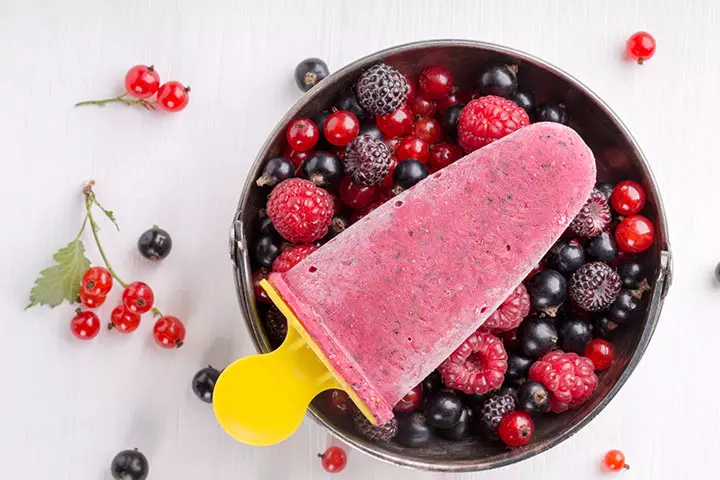
Frozen cranberry yogurt is a good summer recipe that you can start feeding your baby at the age of eight months.The smooth texture recipe has all the goodness of cranberries with added protein, and gut-friendly bacteria from Greek yogurt.
You will need: (servings — 1)
- 1 cup cranberries (fresh or frozen)
- 3tbsp honey
- ½ tsp brown sugar
- ¼ cup blueberries
- 1 cup unsweetened Greek yogurt
How to:
- Take a flat pan and put it on low flame.
- Once the pan gets warm, add cranberries and honey into the pan. Cook for seven to eight minutes or until cranberries release their juice. Simmer for eight to ten minutes and stir the mix occasionally. Once done, put it aside and let it cool.
- Take a bowl and place a sieve on top of it. Put the blanched cranberries on the sieve and press them with the back of a spoon.
- Place all the collected pulp into a blender and add blueberries, Greek yogurt, and brown sugar to it. Blend everything until you get a smooth paste. Ensure that there are no lumps.
- Take some pastry or popsicle molds and fill them with the paste.
- Freeze it in the refrigerator or an ice cream maker. If you are using a refrigerator, then the frozen yogurt will be ready within six hours, although you can leave it in the refrigerator overnight.
- Serve it to your baby in a bowl, or you could also use a popsicle stick while freezing and let your baby enjoy a frozen cranberry popsicle.
 Quick tip
Quick tip3. Cranberry and coconut milk smoothie
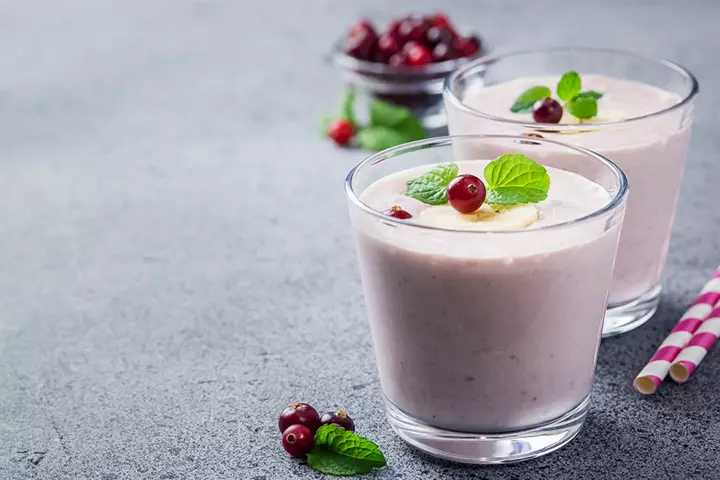
This quick and easy-to-prepare recipe is ideal for babies of about eight months of age. The recipe has coconut milk that intensifies its nutritional value while also making it delectable.
You will need:
- 1/2 cup cranberries (frozen)
- 1 cup coconut milk
- 1 ripe banana or mango
- 1tsp dry fruit powder
- 1 cup water
How to:
- Place all the ingredients in a blender. Blend until you get a smooth, flowy consistency.
- Serve it to your baby right away. You can also refrigerate the smoothie for later use.
Tip: You can also add chia seeds to this recipe to enhance the nutritional value of the smoothie.
4. Cranberry Oatmeal

This quick breakfast recipe can be fed to children older than seven months of age. You may pick the blending consistency for this mixture depending on whether your child prefers a runny consistency or a semisolid puree.
You will need:
- 2 cups rolled oats
- 3½ cups of water
- 1tsp vanilla (optional)
- 1/4 cup dried cranberries
How to:
- Boil the water in a large saucepot.
- Once it begins to boil, add the oats and the vanilla.
- Lower the flame and allow the oats to simmer for approximately 10 minutes.
- Once the water has been absorbed completely, turn off the heat.
- Add the cranberries to this mixture.
- Using an immersion blender or a food processor, blend the mixture until you have obtained the desired consistency.
- Serve warm.
Tip: For older children who have been introduced to nuts and dairy, you may add chopped almonds and/or yogurt as taste enhancers.
5. Cranberry Rice Pudding
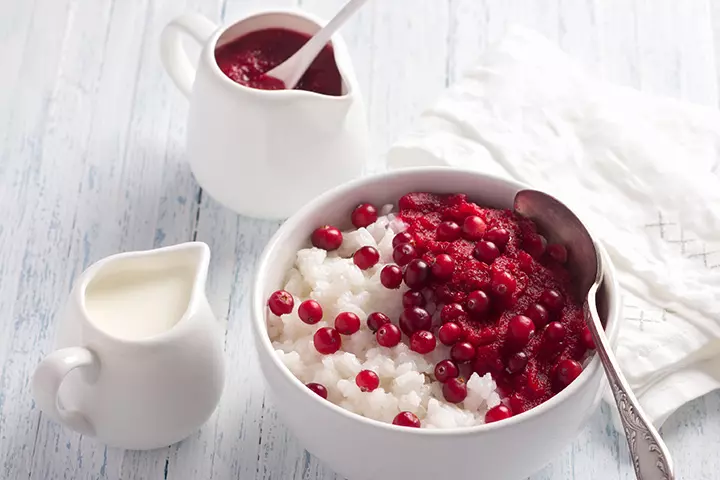
This rice pudding has the goodness of fruits and carbohydrates. This recipe is ideal for babies over six months. You may use more breast or formula milk than mentioned here to adjust the consistency of the pudding.
You will need:
- 1⁄4 cup cooked rice
- 1⁄4 cup milk (formula or breast milk)
- ½ apple (cored and chopped)
- 1⁄8 cup cranberries (dried)
- 1⁄16 tsp vanilla essence
- 1⁄4 pinch cinnamon
- Water (as required)
How to:
- In a saucepan, add rice and milk. Stirring occasionally, simmer for about 10 minutes or until creamy.
- In a microwave-safe bowl, cook the apples and cranberries with some water for about three minutes or until soft.
- Once cooked, puree the apple-cranberry mixture until smooth.
- Mix in the puree, along with vanilla and cinnamon to the rice.
- Using an immersion blender, lightly blend this mixture till smooth.
- Serve warm.
Tip: For children who are older than eight months, you may skip the blending step and serve a chunky pudding.
Frequently Asked Questions
1. Do babies like cranberries?
Cranberries are sweet and slightly acidic, offering a taste your baby’s taste buds have not tried yet. Therefore, they may enjoy it.
2. Can I give my 8-month-old cranberry juice?
Parents are advised against regularly giving juice to babies younger than 12 months since they offer little nutritional value at this age (3).
3. Are there any alternatives to cranberries for babies?
Raspberries, apples, pears, mangoes, and blueberries for babies are some fruits that can be an alternative to cranberries. You can blend or mash these fruits or cut them into thin slices and serve them as finger foods. Speak to your healthcare provider whenever introducing new food to the baby.
4. Can cranberries cause diaper rash in babies?
Cranberries are generally safe for babies to consume. No studies have linked them to diaper rash. However, their acidity may make the urine slightly more acidic, which can irritate a baby’s delicate skin, especially if the area is not properly cleaned (13). If you notice any rash or irritation after your baby eats cranberries, temporarily avoid them and consult a pediatrician.
Cranberries for babies are safe and a good food choice since they are packed with essential nutrients. Cranberries promote digestion, immunity, oral health and reduce oxidative stress and risks of UTIs in babies. You may give cooked cranberries for eight months or more as per pediatricians’ recommendations. It is not recommended to give cranberry juice or any other juices to babies younger than 12 months. However, purees from fresh cranberries are always better. You may purchase fresh cranberries from trusted stores and wash, dry, and store them in a paper bag in the refrigerator.
Infographic: Precautions To Take While Introducing Cranberries To Babies
Cranberries are delectable red fruits with a tart and sweet flavor packed with essential vitamins, minerals, and antioxidants. They can be consumed in a variety of forms, including cooked, dried, canned, and raw. Check out the infographic below for helpful tips on feeding your little one this superfood. Illustration: Momjunction Design Team
Illustration: Amazing Benefits of Cranberries For Babies

Image: Stable Diffusion/MomJunction Design Team
Are you a fan of including cranberries in your diet? Discover how this superfood can help improve your overall health and wellbeing.
References
1. CFR – Code of Federal Regulations Title 21; FDA
2. Melvin B. Heyman et al.; Fruit Juice in Infants, Children, and Adolescents: Current Recommendations; American Academy of Pediatrics
3. Fruit Juice and Your Child’s Diet; American Academy of Pediatrics
4. Cranberries, raw, FDC ID: 171722; Fooddata Central; USFDA
5. Feeding and nutrition of infants and young children; WHO
6. Jeffrey B Blumberg et al.; Impact of Cranberries on Gut Microbiota and Cardiometabolic Health: Proceedings of the Cranberry Health Research Conference 2015; NCBI
7. Meri P Nantz et al.; Consumption of cranberry polyphenols enhances human γδ-T cell proliferation and reduces the number of symptoms associated with colds and influenza: a randomized, placebo-controlled intervention study; NCBI
8. Daniel B. Hannon et al.; Effects of cranberry extracts on gene expression in THP‐1 cells; NCBI
9. Marcelo Hisano et al.; Cranberries and lower urinary tract infection prevention; NCBI
10. Bijo Alexander and Sunil John; Oral Health Benefits of Cranberry: A Review; NCBI
11. Jeffrey B. Blumberg et al.; Cranberries and Their Bioactive Constituents in Human Health; NCBI
12. Kidney Stones; Cleveland Clinic
13. The Cranberry, Health Benefits; Cape Cod Cranberry Growers’ Association
Community Experiences
Join the conversation and become a part of our nurturing community! Share your stories, experiences, and insights to connect with fellow parents.
Read full bio of Cari Riker
Read full bio of Swati Patwal
Read full bio of Rohit Garoo
Read full bio of Ghazia Shah





